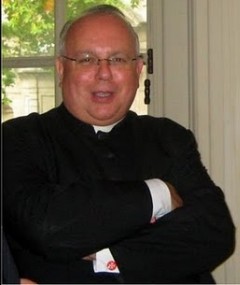

|
| Musical Musings: Liturgy |
|
|
A Giant Leap Forward for the Ordinary Form
Dom Daniel opened the Symposium with a theological reflection on liturgy, noting that the Church must embrace both forms of the Roman Rite. While the Canons regularly celebrate Liturgy according to the Missal of Blessed John XXIII (1962) and the Latin Divine Office, they are supportive and indeed enthusiastic about what the new translation means to the Church today. It embodies a giant leap forward in the way we worship in the vernacular. Here is the timeline that was distributed at the Symposium, an explanation of which comprised the majority of Msgr. Wadsworth's talk.
According to Msgr. Wadsworth, The Mass remains the same, although it will sound different and we shall all have to apply ourselves to receiving this gift from the Church. There will be implications for some of the music used at Mass; Missal chants will now be shared with all English-speaking Catholics. The implementation of the new translation is an opportunity:
The liturgy is something we receive from the Church, not make for ourselves. It is the most obvious sign of our unity of faith and is a powerful instrument of God's grace in our lives. The preparation of this new translation has been, in every sense, a work of the Church. Over 700 English-speaking bishops throughout the world have collaborated in the long process of its preparation and men and women from our own countries have made a key contribution in bringing this work to fruition. Pope Benedict urged us all to make the most of the possibilities the new translation of the Missal offers for genuine renewal when he said:
I encourage you now to seize the opportunity that the new translation offers for in-depth catechesis on the Eucharist and renewed devotion in the manner of its celebration.
"The more lively the eucharistic faith of the people of God, the deeper is its sharing in the ecclesial life in steadfast commitment to the mission entrusted by Christ to his disciples" [Sacrosanctum concilium, 6] At the conclusion of his talk, Msgr. Wadworth entertained questions, during which two very interesting points were made concerning the value of this new English translation, countering its critics who see it as elitist, inflated language encumbered by slavish adherence to Latin style and vocabulary. 1. While there is certainly value per se in using a sacral, elevated language for worship, there are practical considerations as well in lifting the language of worship above the family-room and bar-stool pedantry that plagued the Second Edition translation. There are 11 national conference members of ICEL who will be using this new translation [Australia, Canada, England and Wales, India, Ireland, New Zealand, Pakistan, The Philippines, Scotland, Southern Africa, the United States of America]. Further, there are another 22 nations using English on a partial basis, who will use the translation, but did not participate in its production. On the level of every-day speech, those 33 countries vary greatly in their common parlance, so much so that many idioms are not understood from country to country, even using the same language. To arrive at any consistent uniformity among the language-use groups, one needs to rise at least to the level of literary prosody. On that level, all English speakers can agree — and consequently understand the meaning of the text. This level of literary competence is further embellished with a sacred vocabulary, as Msgr. Wadsworth has noted, that leaves no doubt as to the purpose and efficacy of this prayer-language. 2. The ideal process of translation involves linguistic experts trained in both Latin and their native tongue, who translate directly from one to the other. As fewer and fewer students persue Classical language study (a situation highly lamented by Msgr. Wadsworth), every language group, particularly those outside the Romance language family, does not have the expertise to effect a direct translation from Latin to their native tongue. These groups, particularly among the countries of Africa and Southeast Asia, are turning to the English version as a starting point for translation, since English is rapidly becoming the most widely-understood language on the planet. The importance is thus clear in having a highly accurate English version from which these groups can work. Were the English-speaking Church to pass on to them flawed paraphrases akin to those with which we've lived for forty years, we'd only be perpetuating the liturgical crime of our post-Vatican II haste. |
Submit Your Music / Contact Us / Company Description / Links
 Msgr. Andrew R. Wadsworth [see
Msgr. Andrew R. Wadsworth [see